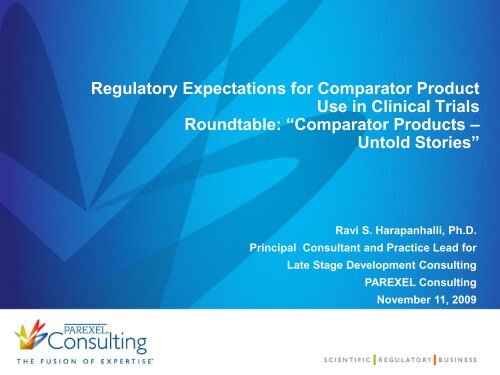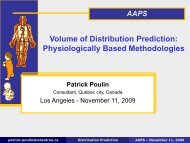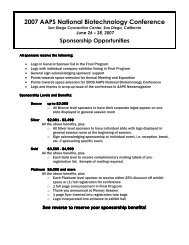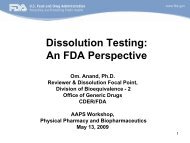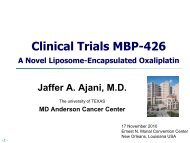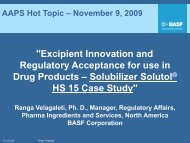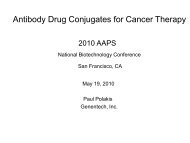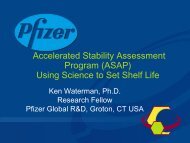Regulatory Expectations for Comparator
Regulatory Expectations for Comparator
Regulatory Expectations for Comparator
You also want an ePaper? Increase the reach of your titles
YUMPU automatically turns print PDFs into web optimized ePapers that Google loves.
<strong>Regulatory</strong> <strong>Expectations</strong> <strong>for</strong> <strong>Comparator</strong> Product<br />
Use in Clinical Trials<br />
Roundtable: “<strong>Comparator</strong> Products –<br />
Untold Stories”<br />
Ravi S. Harapanhalli, Ph.D.<br />
Principal Consultant and Practice Lead <strong>for</strong><br />
Late Stage Development Consulting<br />
PAREXEL Consulting<br />
November 11, 2009
- 2 -<br />
Outline<br />
• Why are comparator products needed<br />
• <strong>Comparator</strong> selection considerations<br />
• Why blinding or masking of comparators<br />
• Blinding strategies<br />
• <strong>Regulatory</strong> considerations (legal, import/export, controlled substances)<br />
• Good blinding practices (GBPs) and regulatory expectations
- 3 -<br />
Why are <strong>Comparator</strong> Products Needed<br />
• NDAs filed under 505(b)(2), ANDAs filed under 505(j)<br />
› Relative bioavailability, Bioequivalence assessments<br />
› 21CFR 320<br />
• Head-to-head clinical studies <strong>for</strong> S/E<br />
› Therapeutic equivalence <strong>for</strong> generics<br />
› Non-inferiority, superiority claims <strong>for</strong> “me too” drugs<br />
› Same or different dosage <strong>for</strong>ms and routes of administration<br />
• Used as standard-of-care or add-on therapy<br />
› E.g. 505(b)(1) NDAs <strong>for</strong> NMEs<br />
• To facilitate approval of follow-on biologics (FOBs) under BLAs/NDAs<br />
› Pending legislation to amend PHS act
- 4 -<br />
<strong>Comparator</strong> Selection Considerations<br />
• Nationally approved<br />
• Most widely prescribed Rx drug<br />
• Sourcing issues<br />
• Suitability of approved product strengths<br />
• Ruggedness to withstand modification/alteration<br />
• History of product recalls<br />
• Global availability in same dosage <strong>for</strong>m, strengths, trade dress<br />
• Reported BE inequivalences across regions<br />
• Import/export issues
- 5 -<br />
<strong>Comparator</strong> Selection Contd..<br />
• Availability/acceptability of comparators in countries of investigation<br />
› Unapproved comparators<br />
› Import/export issues (under investigational use)<br />
› Controlled substances<br />
• Sourcing issues <strong>for</strong> long outcome studies<br />
• Risk of changing comparators in the midst of clinical studies<br />
• COAs <strong>for</strong> comparators<br />
› From innovators<br />
› In-house analysis<br />
• Tracking comparators <strong>for</strong> possible recalls<br />
• <strong>Comparator</strong>s <strong>for</strong> global filing (Thinking globally and acting locally!<br />
› Region-specific BE studies to support one comparator source
- 6 -<br />
<strong>Comparator</strong> Selection <strong>for</strong> FDCs<br />
• Combination rule 21 CFR 300.50<br />
• Factorial design to show individual contributions to the claimed effect<br />
• Often a 5-arm study: Drug A, Drug B, Free combination, FDC A+B, and<br />
placebo<br />
• Expectation is that comparator drugs A and B are individually approved<br />
monotherapies in USA.<br />
• Study to assess bioequivalence of comparator drugs to FDCs are<br />
required to rule out PK/PD interactions.<br />
• Studies using free combinations of comparators versus FDCs may also<br />
be required.
- 7 -<br />
<strong>Comparator</strong> Selection <strong>for</strong> FDCs: Contd…<br />
• What if comparators are not approved as monotherapies<br />
› Use of unapproved comparators<br />
› Use of other approved FDCs containing the comparator drug<br />
› Acceptable only if pharmacokinetic linkage to approved product/strength established<br />
› Bioequivalence creep should be considered <strong>for</strong> multiple bridging<br />
• Example: Use of 5 mg Roxicodone (oxycodone) tablets as comparator <strong>for</strong><br />
Combunox (oxycodone/Ibuprofen 5 mg/400 mg):<br />
› 5-mg Roxicodone is an unapproved product<br />
› Oxycodone in Combunox was BE to 5-mg Roxicodone<br />
› Three 5-mg Roxicodone tablets were BE to the15-mg Roxicodone tablet in the<br />
referenced NDA<br />
› The 15-mg Roxicodone was BE to the oxycodone in three 5-mg Percodan tablets in<br />
another study from the referenced NDA.<br />
› Percodan is an approved product
<strong>Comparator</strong> Selection <strong>for</strong> Biologics<br />
(WHO Draft Guidance on SEBs)<br />
- 8 -<br />
• Harmonization among National <strong>Regulatory</strong> Authorities (NRAs)<br />
• Option to use non-national/non-regional comparator product<br />
• Addressing scientific issues limiting use of comparator products<br />
› Assess the effects of de-<strong>for</strong>mulation and differences in <strong>for</strong>mulation<br />
› Use of publicly available in<strong>for</strong>mation<br />
› Data provided by the manufacturers,<br />
› In<strong>for</strong>mation obtained by the NRA via in<strong>for</strong>mation sharing with other NRAs,<br />
› MOUs with other competent regulators to facilitate in<strong>for</strong>mation sharing.<br />
• Additional guide to use non-nationally licensed comparator products<br />
• Acceptability of one comparator product across regions may streamline<br />
the comparability exercise and minimize redundancies and cost.
- 9 -<br />
Why Blinding or Masking of <strong>Comparator</strong>s<br />
• Double-blind, active-controlled and placebo-controlled studies are<br />
required in many cases to establish efficacy<br />
› Double-blinding improves quality of clinical data<br />
› Minimal bias due to the invisibility of the marketed product<br />
› Matching placebo to assess any potential placebo effect<br />
› Helps in randomization of patients <strong>for</strong> statistical reasons
- 10 -<br />
Blinding Strategies<br />
• Oral dosage <strong>for</strong>ms<br />
› Over-encapsulation<br />
› Film coating<br />
› Wiping off printed inscriptions <strong>for</strong> solid dosage <strong>for</strong>ms<br />
› Repackaging <strong>for</strong> liquids or powders.<br />
• Parenterals<br />
› Choosing container closure systems that are indistinguishable<br />
› Overlabeling with blinding codes
- 11 -<br />
Over-encapsulation of tablets or capsules<br />
• Widely accepted mechanism throughout the clinical supplies industry<br />
• Packaging <strong>for</strong> clinical supplies is a complex process<br />
› strictly controlled by good manufacturing practice (GMP)<br />
• Addition of a product or products to a hard gelatin capsule<br />
• Optional backfilling with an inactive bulk agent or excipient<br />
• Can be used <strong>for</strong> comparator products, investigational medicinal<br />
products (IMP) and/or placebos<br />
• Visually identical capsules <strong>for</strong> each product or strength<br />
• Maintains the blind and removes any potential bias.
- 12 -<br />
Options <strong>for</strong> Over-Encapsulation<br />
Courtesy: Richard Shannon, Head of Business Development (Eur), Almac Clinical Services
- 13 -<br />
Manufacturing Challenges<br />
• Over-encapsulation, bottling, blistering, and labeling<br />
› Variation in batch size<br />
› Multiple, operational set-ups<br />
› Required in-process checks<br />
› Variations in capsule size, coating thickness<br />
› Multiple manufacturing sites<br />
• Uni<strong>for</strong>m flow of excipients used as backfill<br />
• Unique shape or dimensions of input product<br />
• Need to produce new strengths of comparator products<br />
› Promote adherence to the prescribed dosing regimen<br />
› Capsules may contain more than one unit of marketed product<br />
• Re-containerization issues
- 14 -<br />
Manufacturing Considerations<br />
• Excipients<br />
› Primarily to prevent rattling.<br />
› Should remain inactive,<br />
› Should not have effect on the quality of the product<br />
› Should flow efficiently during the over-encapsulation process.<br />
› Flood volume filling or dispensing controlled dose of excipient<br />
• Capsule shells<br />
› Wide range of hard gelatine capsules specifically <strong>for</strong> clinical supplies market<br />
› Range of diameters and lengths allow many products to be over-encapsulated<br />
› Opaque colorations promote better blinding<br />
• Capsule weight check<br />
› Manual inspection or automated vision systems<br />
› Rejection of misfed capsules
- 15 -<br />
Manufacture of Matching Placebo<br />
• Not generally possible to manufacture placebos to branded products<br />
› legal and ethical implications<br />
• Over-encapsulation is a useful procedure<br />
› Manufacture of placebo capsules to contain excipient only<br />
› Manufacture of placebo capsules to contain a placebo tablet or capsule and<br />
excipient<br />
• The placebos should be manufactured to similar specifications as those<br />
utilized during the active over-encapsulation process to maintain the<br />
blind.
- 16 -<br />
Assessing the Impact of <strong>Comparator</strong> Blinding<br />
• The nature and extent of modification/alteration of comparator<br />
• Label per<strong>for</strong>mance retained or altered<br />
• CMC considerations<br />
› Developing minimally invasive blinding process<br />
› Packaging of blinded comparators<br />
› Setting specifications (analytical methods, validation)-<br />
Pharmacopieal/Nonpharmacopial testing<br />
› ID, Assay, impurities, dissolution/per<strong>for</strong>mance<br />
› Conducting appropriate stability program<br />
• Conducting BA/BE studies when needed
- 17 -<br />
Bioequivalence Criteria <strong>for</strong> Blinded <strong>Comparator</strong>s<br />
• Same as general BE criteria<br />
• Ratio of geometric means must fall within the 90% CI <strong>for</strong> AUC and<br />
Cmax: 80 – 125% of the unmasked comparator <strong>for</strong> the abovementioned<br />
values.<br />
• Some differences in Cmax and/or Cmin may be allowed provided:<br />
› they are adequately characterized<br />
› are not essential to the attainment of effective body drug concentrations on<br />
chronic use<br />
› are considered medically insignificant <strong>for</strong> the particular drug product studied.
- 18 -<br />
Legal Challenges of Blinding<br />
• Visible branding of commercial products<br />
• Product/sponsor logos directly onto products<br />
• Patented shapes/designs
- 19 -<br />
Importing <strong>Comparator</strong> Drugs Under a US-IND<br />
› 21 CFR 312.110 (a) Imports.<br />
› Investigational drug label on the comparator product<br />
• Name of the blinded comparator drug<br />
• Manufacturing site<br />
• Name and address of the proposed clinical site<br />
• Contact in<strong>for</strong>mation of the investigator (consignee)<br />
• IND number (effective under 312.40)<br />
• Warning statement “<strong>for</strong> investigational use only”
- 20 -<br />
Exporting <strong>Comparator</strong> Drugs Under A US-IND<br />
• 21 CFR 312.110 (b)(1); IND effective under 312.40<br />
• Receiver named as investigator in IND<br />
• Shipment of the drug <strong>for</strong> use in a clinical investigation authorized by FDA<br />
• Written request by exporter of drug to FDA’s Office of International Affairs Staff<br />
(HFY–50)<br />
• Appropriateness <strong>for</strong> the proposed investigational use in humans<br />
• Limited only <strong>for</strong> investigational purposes<br />
• Legal basis <strong>for</strong> the use of investigational drug by the consignee<br />
• Quantity of the drug to be shipped per shipment<br />
• Frequency of expected shipments.<br />
• Notification of authorization by FDA to the government of the importing country
- 21 -<br />
Exporting <strong>Comparator</strong> Drugs Without A US-IND<br />
• Formal request from an authorized official of the government of the<br />
country to FDA (Office of International Affairs)<br />
› adequate in<strong>for</strong>mation about the drug<br />
› proposed investigational use,<br />
› Limited only <strong>for</strong> investigational purposes<br />
› Reassurance that the drug may legally be used by the intended consignee in<br />
that country.<br />
› Quantity of drug to be shipped per shipment<br />
› Frequency of expected shipments.
- 22 -<br />
Controlled Substances as <strong>Comparator</strong>s<br />
• 312.69 Handling of controlled substances.<br />
• Measures to prevent theft or diversion of the substance into illegal<br />
channels of distribution<br />
› Subject to controlled Substances Act<br />
› Storage of the investigational drug in a securely locked, substantially<br />
constructed cabinet, or enclosure<br />
› Restricted access<br />
• DEA requirements<br />
› Registration of importing/exporting sites<br />
› Permit <strong>for</strong> importation/exportation<br />
› Declaration <strong>for</strong>ms at the time of actual shipment.
Good Blinding Practices and <strong>Regulatory</strong><br />
<strong>Expectations</strong><br />
- 23 -<br />
• Tightly control and scrutinize the manufacturing process<br />
› To be minimally invasive<br />
› To ensure the product is blinded appropriately<br />
› To allow rapid product identification in case of emergency (e.g. recall of comparator<br />
product)<br />
• Demonstrate no significant quality change within the product<br />
› Compendial and/or in-house specifications (ID, assay, impurities, degradants)<br />
› Comparative in vitro product per<strong>for</strong>mance (e.g. dissolution, multi-media, multi-point<br />
profiles and f2)<br />
› Container closure system change and product stability<br />
› Bioavailability (when needed)<br />
• Justify and assign expiry dates and storage conditions<br />
• Document batch records on file and file the in<strong>for</strong>mation in the IND
- 24 -<br />
Thank you <strong>for</strong> your attention!<br />
Ravi.harapanhalli@parexel.com<br />
Work: 301 634 8027<br />
Cell: 240 404 8668


